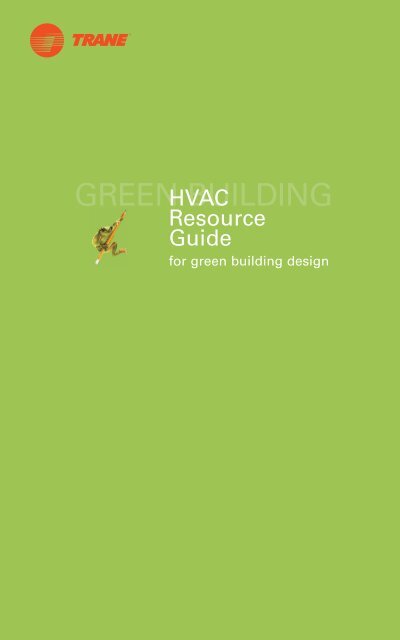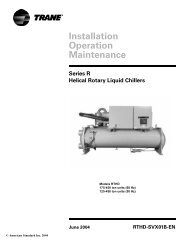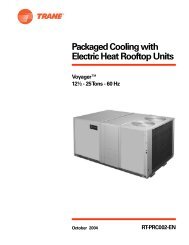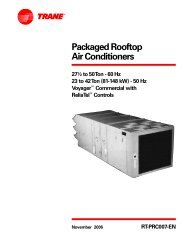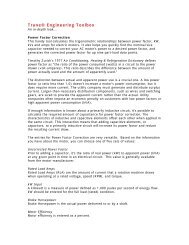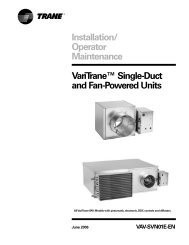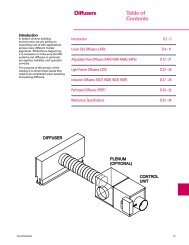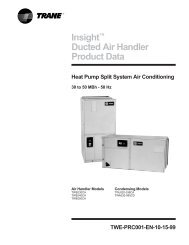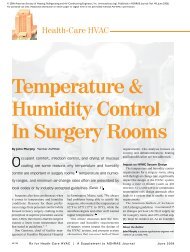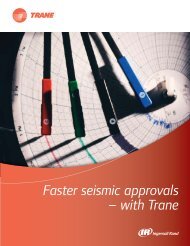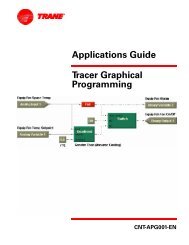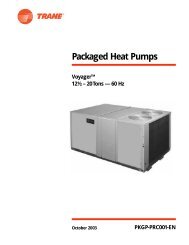HVAC - Resource Guide For Green Building Design - Trane
HVAC - Resource Guide For Green Building Design - Trane
HVAC - Resource Guide For Green Building Design - Trane
Create successful ePaper yourself
Turn your PDF publications into a flip-book with our unique Google optimized e-Paper software.
GREEN BUILDING<br />
<strong>HVAC</strong><br />
<strong>Resource</strong><br />
<strong>Guide</strong><br />
for green building design
Healthy buildings are vital to the world’s economic and social development.<br />
Unfortunately, high energy and other resource use means they<br />
create a significant environmental impact. <strong>Trane</strong> has been a leader<br />
in this field, promoting more sustainable alternatives to conventional<br />
building design and equipment. This practical guidebook to energy efficient<br />
and green <strong>HVAC</strong> design will make an important contribution to<br />
reducing the environmental impact of energy use in buildings, while<br />
making them healthier and more productive places to live and work.<br />
Rob Watson<br />
Founding Chairman<br />
LEED <strong>Green</strong> <strong>Building</strong> Rating System<br />
Board Member, US <strong>Green</strong> <strong>Building</strong> Council<br />
As the environmental impact of buildings becomes more apparent,<br />
a new field called green building is gaining momentum. <strong>Green</strong> or<br />
sustainable building is the practice of creating healthier and more<br />
resource-efficient models of construction, renovation, operation,<br />
maintenance, and demolition. Research and experience increasingly<br />
demonstrate that when buildings are designed and operated with<br />
their lifecycle impacts in mind, they can provide great environmental,<br />
economic, and social benefits.<br />
U.S. Environmental Protection Agency<br />
www.epa.gov/greenbuilding
PREFACE<br />
<strong>Trane</strong> values guide us in our commitment to corporate social responsibility.<br />
We are driven by customers; we recognize the importance of<br />
our people; we operate with integrity; we strive for excellence; we<br />
deliver on our promises. By following these values - by living them every<br />
day - we get closer to our goal of being a model corporate citizen<br />
in the communities where we work and a responsible resident of the<br />
planet where we all live. Since 2004, <strong>Trane</strong> has published an annual<br />
global citizenship report to substantiate our commitment and desire<br />
to be measured not only by our financial performance, but also by our<br />
environmental stewardship and social responsibility.<br />
As a worldwide leader in the <strong>HVAC</strong> industry, <strong>Trane</strong> helps create<br />
environmentally responsible building solutions that deliver energy<br />
performance, reduce power consumption, and save lifecycle cost. We<br />
execute programs to reduce our own impact on global climate change<br />
and help others do the same. And, we support green building initiatives<br />
by investing resources in the various industry committees and<br />
expertise in designing and manufacturing energy-efficient systems for<br />
buildings. Whether it is designing, operating or maintaining high-performance<br />
buildings, <strong>Trane</strong> can help.<br />
This pocket guide is intended to provide quick reference on various<br />
<strong>HVAC</strong> design practices and technologies so that building professionals<br />
can make sound decisions in meeting or exceeding the technical<br />
requirements of a green building. <strong>Green</strong> options are provided along<br />
with the corresponding criteria and benefits. References for further<br />
reading can also be found at the end of the guide. Since system performance<br />
ties closely with individual components and the integration<br />
among them, when combining various system strategies or applications<br />
to achieve a desired outcome, please consult your local <strong>Trane</strong><br />
professionals.<br />
<strong>Trane</strong> compiled this publication with care and made every effort to<br />
ensure the accuracy of information and data provided herein. However,<br />
this offers no guarantee of being error free. <strong>Trane</strong> shall not<br />
assume any risk of the use of any information in this publication; nor<br />
shall <strong>Trane</strong> bear any legal liability or responsibility of the subsequent<br />
engineering design practice.
CONTENTS<br />
EARTHWISE SYSTEMS<br />
Chilled-Water Systems ............................. 2<br />
Air Handling Systems ............................... 4<br />
Water-Source Heat Pump and<br />
Geothermal Heat Pump ........................... 5<br />
DX/Unitary: Rooftop, Split,<br />
Self-Contained ......................................... 6<br />
CONTROL STRATEGIES<br />
Energy Management ............................... 8<br />
Commissioning ........................................ 8<br />
Measurement and Verification ................. 8<br />
EQUIPMENT EFFICIENCY<br />
Unitary Heat Pump .................................. 10<br />
Unitary Air Conditioner ............................. 11<br />
Electric Chiller .......................................... 12<br />
REFRIGERANTS<br />
Theoretical Efficiency ............................... 14<br />
Atmospheric Life ...................................... 14<br />
Ozone Depletion Potential (ODP) ............. 14<br />
Global Warming Potential (GWP) .............. 14<br />
Life Cycle Climate Performance (LCCP) ... 14<br />
WHERE <strong>HVAC</strong> IMPACTS USGBC’s LEED ®<br />
RATING SYSTEM<br />
LEED for New Contruction & Major<br />
Renovation Version 2.2 .................................16<br />
LEED for Existing <strong>Building</strong>s: Operations<br />
and Maintenance (EB) 2008 ........................18<br />
LEED for Core and Shell Development<br />
(CS) 2.0 ........................................................20<br />
ENERGY MODELING<br />
Features ........................................................22<br />
Modeling Steps for LEED.............................23<br />
ASHRAE 90.1-2004 APPENDIX G<br />
Table G3.1.1A ................................................24<br />
Table G3.1.1B ................................................25<br />
REFERENCES .......................................................26
EARTHWISE SYSTEMS<br />
CHILLED-WATER SYSTEMS (CWS)<br />
green options green criteria reference<br />
1<br />
2<br />
Reduce waterflow<br />
rate in<br />
chilled-water<br />
loop (12-20˚F, or<br />
6.7-11.1˚CΔT)<br />
condenser<br />
water loop<br />
(12-18˚F or 6.7-<br />
10˚CΔT)<br />
Variable flow<br />
chilled-water<br />
systems<br />
Vary the<br />
water flow rate<br />
through the<br />
chiller evaporators<br />
during system<br />
operation<br />
• Increase efficiency of chilled-water<br />
plant so that pumps and cooling towers<br />
consume less energy<br />
• Reduce building materials (smaller<br />
pump, cooling tower, fan)<br />
• Reduce water pipe sizes, save cost and<br />
material<br />
Reduce system materials required, using<br />
fewer pumps than the common primarysecondary<br />
system; for example, reduced<br />
• piping connections<br />
• strainers<br />
• electrical connections<br />
• valves and specialties<br />
• pump starters<br />
• space required<br />
Improve system efficiency modestly by<br />
reducing pumping energy.<br />
(1)<br />
(2)<br />
(3)<br />
(4)<br />
(5)<br />
(6)<br />
(7)<br />
3<br />
System optimization<br />
controls<br />
Condenser<br />
water temperature<br />
reset and<br />
optimization<br />
• Improve system efficiency<br />
• Optimize the condenser water system<br />
by balancing the chiller and tower power<br />
• Iterate for the best condenser water<br />
temperature to minimize the combined<br />
chiller-tower energy use at all time<br />
(8)<br />
(9)<br />
4<br />
Pumping pressure-speed<br />
reset<br />
• Reset the pump operating pressure to<br />
ensure that the control valve needing the<br />
highest pressure is about 90% open<br />
• Save pump energy<br />
(10)<br />
5<br />
Refrigerant<br />
charge per ton<br />
Select systems that require less refrigerant<br />
charge to operate<br />
• Less refrigerant means less impact on<br />
the environment in case refrigerant leaks<br />
from the system<br />
• Use ASHRAE Standard 147 to further<br />
minimize leakage or overall refrigerant<br />
emissions<br />
(11)<br />
2
6<br />
7<br />
8<br />
green options green criteria reference<br />
Heat recovery<br />
Series chillers<br />
chilled-water<br />
loop only,<br />
15˚F or<br />
8.3˚C ΔT<br />
Series-series<br />
counter-flow<br />
chilled-water<br />
loop, 20˚F or<br />
11.1˚C ΔT<br />
condenserwater<br />
loop,<br />
20˚F or<br />
11.1˚C ΔT<br />
9 Ice storage<br />
Recover heat from the condenser of a<br />
water-cooled chiller<br />
• to reheat air (for humidity control)<br />
• to preheat outdoor air<br />
• to heat make-up water entering a building<br />
ASHRAE 90.1-2004 requires heat recovery<br />
for service water heating when<br />
• The facility operates 24 hours per day<br />
• The total heat rejection capacity of the<br />
system exceeds 6,000,000 Btu/h of heat<br />
rejection (about a 450-ton chiller)<br />
• The design servicewater heating load<br />
exceeds 1,000,000 Btu/h (293 kW)<br />
• maximum 2 chillers in series<br />
• place heat recovery or more efficient<br />
chiller upstream<br />
• reduce water flow rate, lower chillerpump<br />
system energy<br />
• lower life-cycle cost for larger plant<br />
• chilled-water-leaving end is condenserwater-entering<br />
end, i.e. counter-flow the<br />
chiller and tower power<br />
• reduce water flow rate, half of ARI standard<br />
rating conditions<br />
• Equal lift for each chiller<br />
• load shift, create source energy savings<br />
and reduce emissions<br />
• standby capacity for non-regular peaks<br />
• reduce overall energy cost<br />
(12)<br />
(40)<br />
(41)<br />
(41)<br />
(42)<br />
(43)<br />
(44)<br />
(45)<br />
(46)<br />
3
EARTHWISE SYSTEMS<br />
AIR-HANDLING SYSTEMS<br />
green options green criteria reference<br />
1<br />
Low temp. air<br />
• high-efficiency centrifugal<br />
chiller, 45˚F(7.2˚C)<br />
• screw chiller,<br />
48˚F(8.9˚C)<br />
• rooftop/VAV,<br />
52˚F(11.1˚C)<br />
• Reduce fan energy<br />
• Improve indoor humidity control<br />
• Reduce air duct materials<br />
(47)<br />
(48)<br />
(49)<br />
2<br />
Add an air-to-air heat<br />
exchanger for exhaustair<br />
energy recovery<br />
• Permits downsizing of cooling and heating equipment<br />
• Reduces cooling and heating energy use<br />
(19)<br />
3 Variable-air volume<br />
• Provide appropriate system-level ventilation<br />
• Adequately protect the coils from freezing<br />
• Control space humidity over a wide range of loads<br />
• Control building pressure<br />
(17)<br />
(23)<br />
(32)<br />
(49)<br />
4<br />
Parallel,fan-powered<br />
VAV terminals for those<br />
zones that require heat<br />
• Reduces heating energy<br />
• Increases air motion during heating season<br />
(49)<br />
5<br />
Series desiccant wheel<br />
(<strong>Trane</strong> CDQ TM )<br />
• Improve the dehumidification ability of a cold coil<br />
• Humidity control 24/7, 365 days per year<br />
• Use standard air conditioning equipment<br />
• Reduce energy cost of dehumidification<br />
(63)<br />
(64)<br />
6 High efficiency fans<br />
• Energy efficiency improvement<br />
• Reduce operating time for boiler<br />
(16)<br />
7<br />
Factory-mounted and<br />
factory-commissioned<br />
controls<br />
• Reduce the human error and amount of time spent<br />
installing and commissiong the system<br />
8<br />
Brushless DC motor<br />
(ECM) for VAV boxes<br />
• Efficiency benefit as compared to AC<br />
motors, particularly in series VAV terminals<br />
• Factory flow-rate preset reducing air balancing<br />
expense<br />
• Precise speed–torque control<br />
(66)<br />
(49)<br />
9<br />
Electricallyenhanced<br />
air filters<br />
• Reduce air pressure drop to increase energy<br />
efficiency<br />
10 Air filtration/purification<br />
Particulate<br />
• 10 microns or less generally pose the greatest<br />
health hazard because they are small enough<br />
to penetrate the natural defenses of the body’s<br />
respiratory system.<br />
• Min. efficiency MERV 6 and located upstream of<br />
all cooling coils<br />
Gaseous<br />
• Originated from building materials or VOC of cleaning<br />
agents<br />
• Source control: negative pressure, dilution,<br />
absorption<br />
• Disable fan operation when a dirty filter alarm is<br />
present, a dirty filter light is on, or filter media is<br />
absent.<br />
(36)<br />
(37)<br />
(38)<br />
4
WATER/GROUND-SOURCE HEAT PUMP SYSTEMS<br />
green options green criteria reference<br />
1<br />
2<br />
3<br />
Water-source<br />
heat-pump<br />
system variable<br />
water flow<br />
Reduce the<br />
flow rates in<br />
the condenser<br />
water system<br />
Consider using<br />
a geothermal<br />
well field<br />
At non-design load conditions, reduce<br />
water flow rate in the heat-pump system<br />
• Install two position valves at each heat<br />
pump that close when the heat pump<br />
turns off<br />
• Install a pump that can reduce its energy<br />
consumption at reduced flow rates<br />
• on large applications install a variable<br />
speed drive on the pump<br />
Use a flow rate of 2 gpm/ton<br />
(0.126 l/s per ton)<br />
Perform a life cycle cost analysis on a<br />
geothermal heat pump system<br />
(13)<br />
(14)<br />
(56)<br />
(15)<br />
(56)<br />
4 Heat recovery<br />
5<br />
High efficiency<br />
(<strong>Green</strong>er) products<br />
Recover energy from the water loop<br />
• Reduce operating time for cooling tower<br />
• Reduce operating time for boiler<br />
Consider using the highest efficiency<br />
heat pumps available<br />
(16)<br />
6<br />
Deliver conditioned<br />
outdoor<br />
air cold directly<br />
to the spaces<br />
• Permits downsizing of heat pumps<br />
• Reduces cooling energy use<br />
(30)<br />
(56)<br />
(17)<br />
7<br />
Add an air-to-air<br />
heat exchanger<br />
for exhaust-air<br />
energy recovery<br />
• Permits downsizing of cooling and heating<br />
equipment<br />
• Reduces cooling and heating energy use<br />
(19)<br />
5
EARTHWISE SYSTEMS<br />
DX UNITARY SYSTEMS ROOFTOP, SPLIT, SELF-CONTAINED<br />
green options green criteria reference<br />
1<br />
2<br />
3<br />
4<br />
5<br />
6<br />
7<br />
8<br />
Avoid oversizing<br />
supply airflow and<br />
cooling capacity<br />
Avoid using hotgas<br />
bypass unless<br />
it is absolutely<br />
required<br />
Select high-efficiency<br />
equipment<br />
Consider using<br />
an air-to-air heat<br />
pump equipment<br />
(may not be suitable<br />
for extreme<br />
cold climates)<br />
Include an airside<br />
economizer (or<br />
waterside)<br />
Add an air-to-air<br />
heat exchanger<br />
for exhaust-air<br />
energy recovery<br />
Use variable air<br />
volume (VAV) in<br />
a multiple-zone<br />
system<br />
Directly control<br />
space humidity by<br />
overcooling and<br />
reheating supply<br />
air using refrigerant<br />
heat recovery<br />
• Improves comfort control<br />
• Improves dehumidification<br />
performance<br />
• Reduces overall energy use<br />
• Minimizes the risk of refrigerant leaks<br />
in a DX split system due to less fieldinstalled<br />
refrigerant piping<br />
• Reduces overall energy use<br />
• Reduces heating energy use during<br />
mild outdoor conditions because a<br />
heat pump is a more efficient heater<br />
than hot water, steam, gas or electric<br />
heat<br />
• Reduces cooling energy use during<br />
mild non-humid outdoor conditions<br />
• Permits downsizing of cooling and<br />
heating equipment<br />
• Reduces cooling and heating energy<br />
use<br />
• Reduces energy use at part-load conditions<br />
• Improves part-load dehumidification<br />
performance<br />
• Improves comfort and IAQ by allowing<br />
direct control of space humidity (below<br />
a desired upper limit)<br />
• Avoids the use of “new” energy for<br />
reheat<br />
(17)<br />
(18)<br />
(21)<br />
(49)<br />
(19)<br />
(17)<br />
(21)<br />
(49)<br />
(17)<br />
(22)<br />
6
9<br />
10<br />
green options green criteria reference<br />
Provide “powered<br />
exhaust” (on/off<br />
central exhaust<br />
fan) for control of<br />
building pressure<br />
in a constantvolume<br />
system<br />
with an airside<br />
economizer.<br />
Provide modulating<br />
central<br />
exhaust for direct<br />
control of building<br />
pressure in a VAV<br />
system with an<br />
airside economizer.<br />
Avoid using DX<br />
system for large<br />
building with low<br />
diversity or high<br />
utilization<br />
• Maximizes the benefit of the airside<br />
economizer, thereby reducing cooling<br />
energy use during mild outdoor conditions<br />
• Helps minimize risk of moisture-related<br />
problems in the occupied spaces or<br />
building envelope<br />
• Reduces fan energy use by minimizing<br />
the operation of the central exhaust<br />
fan<br />
2<br />
• Area >430,000ft (40,000 m 2 ), full airconditioned<br />
2<br />
• Area >215,000ft (20,000 m 2 ), cooling<br />
only<br />
• Example: office, hotel, hospital<br />
(23)<br />
(24)<br />
7
CONTROL STRATEGIES<br />
ENERGY MANAGEMENT, COMMISSIONING,<br />
MEASUREMENT AND VERIFICATION<br />
green option green criteria reference<br />
1 Night setback<br />
2<br />
3<br />
4<br />
5<br />
6<br />
7<br />
8<br />
Fan pressure<br />
optimization<br />
Wider indoor<br />
temperature range<br />
Operable window<br />
with <strong>HVAC</strong> override<br />
Optimal start and<br />
stop<br />
Water loop optimization<br />
for watersource<br />
heat-pump<br />
system<br />
Wireless zone<br />
sensor<br />
temperature<br />
Auto<br />
commissioning<br />
• Allow cooling setpoint to be set up to<br />
90˚F (32˚C) during unoccupied times<br />
• Allow heating setpoint to be set down<br />
to 60˚F (16˚C) during unoccupied times<br />
• Reset the fan operating pressure to<br />
ensure that the control damper needing<br />
the highest pressure is nearly wide<br />
open.<br />
• Reduce fan operating pressure and<br />
power<br />
• Required feature for DDC/VAV systems<br />
(25)<br />
(10)<br />
(25)<br />
(49)<br />
• Control deadband of 5˚F or 3˚C<br />
(25)<br />
• Open windows to provide natural<br />
ventilation when outdoor conditions<br />
are appropriate<br />
• When windows are open, do not allow<br />
<strong>HVAC</strong> system to operate<br />
• Start the <strong>HVAC</strong> system as late as<br />
possible while still reaching the space<br />
setpoint when it will be occupied<br />
• Stop the system to allow space conditions<br />
to “float” prior to all occupants<br />
leaving the space<br />
• Optimal start is required for systems<br />
with air flow rate >10,000 cfm<br />
(4.72m 3 /s)<br />
• Use system level controls to determine<br />
the optimal loop water temperature<br />
to minimize energy consumption<br />
of the water-source heat pump units<br />
and cooling towers.<br />
• enhance comfort controllability<br />
• better flexibility in space layout<br />
• use factory mounted/calibrated<br />
controllers<br />
• compatible with open, standard<br />
protocols<br />
• reduce on-site time and errors<br />
(25)<br />
(20)<br />
(25)<br />
(49)<br />
(56)<br />
(56)<br />
(51)<br />
(52)<br />
8
green option green criteria reference<br />
9 3D graphics<br />
• build interactive display for visitor’s<br />
center<br />
• visualize system operation<br />
(53)<br />
10 Measurement<br />
and verification<br />
11<br />
12<br />
Ventilation optimization<br />
Supply Airflow<br />
measurement<br />
• trend log by the building energy consumption<br />
overtime<br />
• compare and benchmark the energy<br />
performance to the original design<br />
estimates<br />
• Regulate the outdoor air-flow rate<br />
based on the actual need for ventilation,<br />
as indicated by (any of):<br />
• Occupancy sensors<br />
• Carbon dioxide sensors<br />
• Occupancy schedules<br />
• Use factory-mounted piezometer ring<br />
to enhance the accuracy of the airflow<br />
measurement<br />
(20)<br />
(29)<br />
(30)<br />
(49)<br />
9
EQUIPMENT<br />
UNITARY HEAT PUMP EFFICIENCY<br />
equipment<br />
Groundwater-<br />
source<br />
test<br />
procedure<br />
ARI<br />
340/<br />
360<br />
cooling<br />
eff.<br />
(greener)<br />
Air-<br />
cooled<br />
Water-<br />
source<br />
ISO-<br />
13256-1<br />
ISO-<br />
13256-1<br />
size<br />
≥65,000<br />
Btu/h<br />
(19.0kW)<br />
and<br />
equipment<br />
test<br />
procedure<br />
size<br />
cooling<br />
efficiency<br />
(green)<br />
heating<br />
efficiency<br />
(green)<br />
cooling<br />
eff.<br />
(greener)<br />
heating<br />
efficiency<br />
(greener)<br />
Ground-<br />
source<br />
ISO-<br />
13256-1<br />
EQUIPMENT<br />
ELECTRIC CHILLER EFFICIENCY<br />
size efficiency efficiency<br />
equipment<br />
(tons) (green) (greener)<br />
Air-cooled,<br />
with condenser<br />
Air-cooled,<br />
without<br />
condenser<br />
Watercooled,<br />
positive<br />
displacement<br />
(screw/<br />
scroll)<br />
All<br />
All<br />
NOTES:<br />
13
REFRIGERANTS<br />
refrigerant<br />
theoretical<br />
efficiency<br />
(COP)<br />
atmospheric<br />
life<br />
(years)<br />
ozone<br />
depletion<br />
potential<br />
(ODP)<br />
global<br />
warming<br />
potential<br />
(GWP)<br />
life cycle<br />
climate<br />
performance<br />
(LCCP)<br />
[kg.CO2<br />
equivalent]<br />
R123 11.38 1.3 0.02 76 7,812,400<br />
R134a 10.89 14.0 ~0 1320 8,997,000<br />
R410A 10.51 blend ~0 1890 8,312,900<br />
R407C 10.69 blend ~0 1700 N/A<br />
reference<br />
(27)<br />
(28)<br />
Note:<br />
1. LCCP for 350 ton (1200 kW) chiller in Atlanta office building, 1999 efficiency<br />
level. (see p. 7-9, ref. 27)<br />
2. R410A is a mixture (blend) of R32 and R125 with atmospheric life 4.9 and<br />
29 years respectively.<br />
3. R407C is a mixture (blend of R32, R125 and R134a with atmospheric life<br />
4.9, 29 and 14 years respectively.<br />
<strong>For</strong> refrigerant selection, consider all five environmental factors above PLUS<br />
equipment leak tightness.<br />
An integrated environmental assessment of refrigerant selection is as follows,<br />
which has been adopted for LEED ® <strong>Green</strong> <strong>Building</strong> Rating System starting in<br />
2006. (ref. 31):<br />
LCGWP + LCODP x 10 5 ≤100<br />
Where:<br />
LCODP = [ODPr x (Lr x Life +Mr) x Rc]/Life<br />
LCGWP= [GWPr x (Lr x Life +Mr) x Rc]/Life<br />
LCODP: Lifecycle Ozone Depletion Potential (lbCFC11/Ton-Year)<br />
LCGWP: Lifecycle Direct Global Warming Potential (lbCO 2<br />
/Ton-Year)<br />
GWPr: Global Warming Potential of Refrigerant (0 to 12,000 lbCO 2<br />
/lbr)<br />
ODPr: Ozone Depletion Potential of Refrigerant (0 to 0.2 lbCFC11/lbr)<br />
Lr: Refrigerant Leakage Rate (0.5% to 2.0%; default of 2% unless<br />
otherwise demonstrated)<br />
Mr: End-of-life Refrigerant Loss (2% to 10%; default of 10% unless<br />
otherwise demonstrated)<br />
Rc: Refrigerant Charge (0.5 to 5.0 lbs of refrigerant per ton of gross<br />
ARI-rated cooling capacity)<br />
Life: Equipment Life (10 years; default based on equipment type, unless<br />
otherwise demonstrated)<br />
14
<strong>For</strong> multiple equipment at a site, a weighted average of all base building level<br />
<strong>HVAC</strong>&R equipment shall be applied using the following formula:<br />
[ (LCGWP + LCODP x 10 5 ) x Qunit] / Qtotal ≤100<br />
Where:<br />
Qunit:<br />
Qtotal:<br />
Gross ARI-rated cooling capacity of an individual <strong>HVAC</strong> or refrigeration<br />
unit (tons)<br />
Total Gross ARI-rated cooling capacity of all <strong>HVAC</strong> or refrigeration<br />
Note: A calculation spreadsheet is available for download at<br />
www.trane.com/LEED<br />
LEED ® -NC 2.2 REFERENCE GUIDE<br />
maximum refrigerant charge lb/ton,<br />
refrigerant<br />
based on equipment life*<br />
10 year life 15 year life 20 year life 23 year life<br />
(Room or<br />
window<br />
AC & heat<br />
pumps)<br />
(Unitary, split<br />
and packaged<br />
AC and heat<br />
pumps)<br />
(Reciprocating<br />
compressors &<br />
chillers)<br />
(Centrifugal,<br />
screw & absorption<br />
chillers)<br />
R22 0.57 0.64 0.69 0.71<br />
R123 1.60 1.80 1.92<br />
1.97 (note <strong>Trane</strong><br />
is 5.15)**<br />
R134a 2.52 2.80 3.03 3.10<br />
R245fa 3.26 3.60 3.92 4.02<br />
R407C 1.95 2.20 2.35 2.41<br />
R410A 1.76 1.98 2.11 2.17<br />
*Values shown are based on LEED-NC 2.2 Reference <strong>Guide</strong> EAc4, Table 2<br />
** An official Credit Interpretation Ruling issued by the U.S. <strong>Green</strong> <strong>Building</strong><br />
Council allows the use of a 0.5% refrigerant leakage rate for <strong>Trane</strong> HCFC-<br />
123 CenTraVac centrifugal chillers, (model numbers CVHE, CVHF, CVHG,<br />
CDHF, or CDHG), rather than the default assumption of 2%. This value is<br />
used in the calculations for achieving Energy & Atmosphere Credit 4 of<br />
LEED-NC (version 2.2). With this 0.5% leakage rate, the maximum allowable<br />
refrigerant charge for <strong>Trane</strong> HCFC-123 centrifugal chillers is 5.15 lb/ton (rather<br />
than 1.97 lb/ton, as listed in Table 2 of the LEED-NC Reference <strong>Guide</strong>).<br />
15
<strong>HVAC</strong> IMPACT on LEED ®<br />
LEED FOR NEW CONSTRUCTION (NC) 2.2<br />
LEED-NC credit<br />
WE1.2: Water Efficient Landscaping:<br />
no potable water use or no irrigation<br />
EAp1: Fundamental Commissioning<br />
of the <strong>Building</strong> Energy Systems<br />
LEED<br />
points<br />
building<br />
control<br />
<strong>HVAC</strong><br />
equipment<br />
reference<br />
1 (57)<br />
Preq. (65)<br />
EAp2: Minimum Energy Performance Preq. <br />
EAp3: Fundamental Refrigerant<br />
Management<br />
Preq.<br />
•<br />
EAc1: Optimize Energy Performance 2-10 <br />
(20)<br />
(49)<br />
(56)<br />
(57)<br />
(58)<br />
(59)<br />
(61)<br />
(57)<br />
(60)<br />
(20)<br />
(49)<br />
(56)<br />
(57)<br />
(58)<br />
(59)<br />
(61)<br />
(62)<br />
EAc3: Enhanced Commissioning 1 (65)<br />
EAc4: Enhanced Refrigerant Management<br />
1 •<br />
(57)<br />
(60)<br />
EAc5: Measurement & Verification 1 • (68)<br />
MRc4.1, 4.2: Recycled Content (57)<br />
MRc5.1, 5.2: Regional Materials (57)<br />
EQp1: Minimum IAQ Performance Preq • • (57)<br />
EQp2: Environmental Tobacco<br />
Smoke (ETS) Control<br />
EQc1: Outdoor Air Delivery Monitoring<br />
Preq <br />
1 • •<br />
(20)<br />
(57)<br />
EQc2: Increased Ventilation 1 • • (57)<br />
EQc3.1: Construction IAQ Management<br />
Plan: During Construction<br />
1 (57)<br />
16
LEED-NC credit<br />
EQc3.2: Construction IAQ Management<br />
Plan: Before Occupancy<br />
EQc5: Indoor Chemical & Pollutant<br />
Source Control<br />
EQc6.1: Controllability of Systems:<br />
Lighting<br />
EQc6.2: Controllability of Systems:<br />
Thermal Comfort<br />
LEED<br />
points<br />
building<br />
control<br />
1 <br />
<strong>HVAC</strong><br />
equipment<br />
reference<br />
1 (57)<br />
1 •<br />
1 •<br />
(37)<br />
(67)<br />
EQc7.1: Thermal Comfort: <strong>Design</strong> 1 (67)<br />
IDc1.1-1.4: Innovation in <strong>Design</strong> 4 (53)<br />
IDc2: LEED Accredited Professional 1<br />
Note:<br />
• Main component in gaining LEED point<br />
Assist in gaining LEED point<br />
p: Prerequisite in LEED rating system: a must perform item without exceptions;<br />
no points for the prerequisites.<br />
c: LEED credit<br />
LEED-NC 2.2 POINTS THAT TRANE CAN IMPACT<br />
LEED-NC category<br />
LEED<br />
points<br />
<strong>Trane</strong><br />
assists<br />
Sustainable Sites SS 14 -<br />
Water Efficiency WE 5 1<br />
Energy & Atmosphere EA 17 13<br />
Materials & <strong>Resource</strong>s MR 13 -<br />
Indoor Environmental Quality EQ 15 8<br />
Innovation & <strong>Design</strong> Process ID 5 5<br />
TOTAL 69 27<br />
Certified: 26-32; Silver: 33-38; Gold: 39-51; Platinum: 52-69<br />
17
<strong>HVAC</strong> IMPACT on LEED ®<br />
LEED FOR EXISTING BUILDINGS: OPERATIONS &<br />
MAINTENANCE (EB) 2008<br />
LEED-EB O&M credit<br />
WEc3.1: Water Efficient Landscaping<br />
– 50% reduction<br />
WEc4.2: Cooling Tower Water Management<br />
EAp1: Energy Efficiency Best<br />
Management Practices – Planning,<br />
Documentation, and Opportunity<br />
Assessment<br />
EAp2: Minimum Energy Efficiency<br />
Performance<br />
EAp3: Refrigerant Management<br />
– Ozone Protection<br />
EAc1: Optimize Energy Efficiency<br />
Performance<br />
EAc2.1, 2.2, 2.3: Existing <strong>Building</strong><br />
Commissioning: Investigation and<br />
Analysis, Implementation, Ongoing<br />
Commissioning<br />
EAc3.1, 3.2, 3.3: Performance<br />
Measurement – <strong>Building</strong> Automation<br />
System, System Level Metering<br />
LEED<br />
points<br />
building<br />
control<br />
<strong>HVAC</strong><br />
equipment<br />
reference<br />
1 (57)<br />
1 (57)<br />
req. (65)<br />
req. <br />
req.<br />
•<br />
2-15 <br />
EAc5: Refrigerant Management 1 •<br />
EAc6: Emissions Reduction Reporting<br />
EQp1: Outdoor Air Introduction and<br />
Exhaust Systems<br />
(20)<br />
(49)<br />
(56)<br />
(57)<br />
(58)<br />
(59)<br />
(61)<br />
(57)<br />
(60)<br />
(20)<br />
(49)<br />
(56)<br />
(57)<br />
(58)<br />
(59)<br />
(61)<br />
6 (65)<br />
3 • • (65)<br />
1 <br />
(57)<br />
(60)<br />
req. • • (57)<br />
18
LEED-EB O&M credit<br />
EQp2: Environmental Tobacco Smoke<br />
(ETS) Control<br />
EQc1.1~1.5: IAQ Best Management<br />
Practices: IAQ Management Program,<br />
Outdoor Air Delivery Monitoring,<br />
Increased Ventilation, Reduce<br />
Particulates in Air Distribution,<br />
Management for Facility Alterations<br />
and Additions<br />
LEED<br />
points<br />
building<br />
control<br />
req. <br />
<strong>HVAC</strong><br />
equipment<br />
reference<br />
5 (57)<br />
EQc2.2: Occupant Comfort: Occupant-Controlled<br />
Lighting<br />
1 • (65)<br />
EQc2.3: Occupant Comfort: Thermal<br />
Comfort Monitoring<br />
1 • • (65)<br />
IOc1.1-1.4: Innovation in Operations 4 <br />
IOc2: LEED Accredited Professional 1<br />
Note:<br />
• Main component in gaining LEED point<br />
Assist in gaining LEED point<br />
p: Prerequisite in LEED rating system: a must perform item without exceptions;<br />
no points for the prerequisites.<br />
c: LEED credit<br />
LEED-EB O&M POINTS THAT TRANE CAN IMPACT<br />
LEED<br />
LEED-EB O&M category<br />
points<br />
<strong>Trane</strong><br />
assists<br />
Sustainable Sites SS 12 -<br />
Water Efficiency WE 10 2<br />
Energy & Atmosphere EA 30 26<br />
Materials & <strong>Resource</strong>s MR 14 -<br />
Indoor Environmental Quality EQ 19 7<br />
Innovation In Operations IO 7 5<br />
TOTAL 92 40<br />
Certified: 34-42; Silver: 43-50; Gold: 51-67; Platinum: 68-92<br />
19
<strong>HVAC</strong> IMPACT on LEED ®<br />
LEED FOR CORE AND SHELL DEVELOPMENT (CS) 2.0<br />
<strong>HVAC</strong><br />
LEED<br />
building<br />
LEED-CS credit<br />
equipment<br />
points<br />
control<br />
WEc1.2: Water Efficient Landscaping<br />
– No Potable Water Use or no<br />
Irrigation<br />
EAp1: Fundamental Commissioning<br />
of the <strong>Building</strong> Energy Systems<br />
reference<br />
1 (57)<br />
req. (65)<br />
EAp2: Minimum Energy Performance req. <br />
EAp3: Fundamental Refrigerant<br />
Management<br />
•<br />
EAc1: Optimize Energy Performance 2-8 <br />
(20)<br />
(49)<br />
(56)<br />
(57)<br />
(58)<br />
(59)<br />
(61)<br />
(57)<br />
(60)<br />
(20)<br />
(49)<br />
(56)<br />
(57)<br />
(58)<br />
(59)<br />
(61)<br />
EAc3: Enhanced Commissioning 1 (65)<br />
EAc4: Enhanced Refrigerant Management<br />
EAc5.1, 5.2: Measurement &<br />
Verification – Base <strong>Building</strong>, Tenant<br />
Sub-metering<br />
1 •<br />
(57)<br />
(60)<br />
2 • (68)<br />
MRc4.1, 4.2: Recycled Content (57)<br />
MRc5.1, 5.2: Regional Materials (57)<br />
EQp1: Minimum IAQ Performance req. • • (57)<br />
EQp2: Environmental Tobacco Smoke<br />
(ETS) Control<br />
EQc1: Outdoor Air Delivery Monitoring<br />
req. <br />
1 • • (57)<br />
EQc2: Increased Ventilation 1 • • (57)<br />
20
LEED-CS credit<br />
EQc3: Construction IAQ Management<br />
Plan: During Construction<br />
EQc5: Indoor Chemical &<br />
Pollutant Source Control<br />
EQc6: Controllability of<br />
Systems: Thermal Comfort<br />
LEED<br />
points<br />
building<br />
control<br />
<strong>HVAC</strong><br />
equipment<br />
reference<br />
1 (57)<br />
1 (57)<br />
1 •<br />
(37)<br />
(67)<br />
EQc7: Thermal Comfort: <strong>Design</strong> 1 (67)<br />
IDc1.1-1.4: Innovation in <strong>Design</strong> 4 (53)<br />
IDc2: LEED Accredited Professional 1<br />
Note:<br />
• Main component in gaining LEED point<br />
Assist in gaining LEED point<br />
p: Prerequisite in LEED rating system: a must perform item without exceptions;<br />
no points for the prerequisites.<br />
c: LEED credit<br />
LEED-CS POINTS THAT TRANE CAN IMPACT<br />
LEED-CS category<br />
LEED<br />
points<br />
<strong>Trane</strong><br />
assists<br />
Sustainable Sites SS 15 -<br />
Water Efficiency WE 5 1<br />
Energy & Atmosphere EA 14 12<br />
Materials & <strong>Resource</strong>s MR 11 -<br />
Indoor Environmental Quality EQ 11 6<br />
Innovation In <strong>Design</strong> Process ID 5 5<br />
TOTAL 61 24<br />
Certified: 23-27; Silver: 28-33; Gold: 34-44; Platinum: 45-61<br />
21
ENERGY MODELING<br />
FEATURES OF TRACE 700<br />
1<br />
green option<br />
Modeling<br />
functionality<br />
green criteria<br />
reference<br />
• All systems listed in this guide<br />
• All control strategies listed in this guide (61)<br />
2 Integration<br />
• ASHRAE Standard 90.1 equipment library<br />
• gbXML (green building XML)<br />
• Weather files and templates<br />
• ASHRAE 62.1-2004 Ventilation Rate Procedure<br />
• <strong>Building</strong> Information Modeling (BIM)and<br />
more<br />
(61)<br />
3 Compliance<br />
• Complies with Appendix G for Performance<br />
Rating Method of ASHRAE Standard 90.1-<br />
2004<br />
• Auto-building rotations for LEED baseline<br />
building<br />
• Approved by the IRS for energy-savings<br />
certification (Energy Policy Act 2005)<br />
• Compliance with ANSI/ASHRAE Standard<br />
140–2004<br />
(61)<br />
22
MODELING STEPS FOR LEED<br />
(Peformance Rating Method in Appendix G of ASHRAE Standard 90.1-2004)<br />
1<br />
green option<br />
Model the<br />
proposed design<br />
according<br />
to Section G3<br />
green criteria<br />
• All end-use loads<br />
• Energy-saving strategies<br />
• Actual lighting power<br />
• Energy-saving architectural features<br />
• Not yet designed systems as identical to<br />
the baseline design<br />
reference<br />
(59)<br />
2<br />
Model the<br />
baseline<br />
design in<br />
according to<br />
Section G3<br />
• Set the lighting power density to the maximum<br />
value allowed for the building type<br />
per Table 9.5.1;<br />
• Omit the economizer, as allowed by Table<br />
G3.1.2.6A;<br />
• Change the <strong>HVAC</strong> systems type and<br />
description per Table G3.1.1A and G3.1.1B,<br />
based on the building type and size;<br />
• Use the minimum efficiencies specified in<br />
Table 6.8.1A (cooling) and 6.8.1E (heating);<br />
• Oversize the cooling and heating equipment<br />
based on requirements in Section<br />
G3.1.2.2<br />
(59)<br />
3<br />
Calculate the<br />
energy performance<br />
of<br />
the proposed<br />
design<br />
• Entire year simulation required<br />
(8760 hours)<br />
(58)<br />
(59)<br />
4<br />
Calculate the<br />
energy performance<br />
of<br />
the baseline<br />
design<br />
• Cooling and heating equipment is sized at<br />
115% and 125%, respectively.<br />
• Four orientation simulations (rotating 0°,<br />
90°, 180°, 270°) and the average of the<br />
four results is the baseline building energy<br />
performance<br />
(59)<br />
5<br />
Calculate the<br />
percentage<br />
improvement<br />
and correlate<br />
number of<br />
LEED points<br />
attained<br />
• Apply the formula:<br />
• Correlate number of LEED points gained<br />
from LEED-NC EAc1 table<br />
(59)<br />
23
ASHRAE 90.1-2004 APPENDIX G<br />
TABLE G3.1.1A BASELINE SYSTEM TYPES<br />
fossil fuel, fossil/electric hybrid, &<br />
buidling type<br />
purchased heat<br />
Residential<br />
System 1 - PTAC<br />
electric and other<br />
System 2 - PTHP<br />
Nonresidential &<br />
3 floors or less &<br />
TABLE G3.1.1 B BASELINE SYSTEM DESCRIPTIONS<br />
cooling<br />
system no. system type fan control<br />
type<br />
1. PTAC<br />
2. PTHP<br />
3. PSZ-AC<br />
4. PSZ-HP<br />
5. Packaged<br />
VAV<br />
w/reheat<br />
6. Packaged<br />
VAV<br />
w/PFP<br />
boxes<br />
7. VAV<br />
w/reheat<br />
8. VAV<br />
w/PFP<br />
boxes<br />
Packaged terminal air<br />
conditioner<br />
Packaged terminal<br />
heat pump<br />
Packaged rooftop air<br />
conditioner<br />
Packaged rooftop heat<br />
pump<br />
Packaged rooftop variable-air<br />
volume with<br />
reheat<br />
Packaged rooftop variable-air<br />
volume with<br />
reheat<br />
Packaged rooftop variable-air<br />
volume with<br />
reheat<br />
Variable-air volume<br />
with reheat<br />
Constant<br />
volume<br />
Constant<br />
volume<br />
Constant<br />
volume<br />
Constant<br />
volume<br />
VAV<br />
VAV<br />
VAV<br />
VAV<br />
Direct<br />
expansion<br />
Direct<br />
expansion<br />
Direct<br />
expansion<br />
Direct<br />
expansion<br />
Direct<br />
expansion<br />
Direct<br />
expansion<br />
Chilled<br />
water<br />
Chilled<br />
water<br />
heating<br />
type<br />
Hot water<br />
fossil fuel<br />
boiler<br />
Electric<br />
heat pump<br />
Fossil fuel<br />
furnace<br />
Electric<br />
heat pump<br />
Hot water<br />
fossil fuel<br />
boiler<br />
Electric<br />
resistance<br />
Hot water<br />
fossil fuel<br />
boiler<br />
Electric<br />
resistance<br />
25
REFERENCE REFERENCE<br />
1. CoolToolsTM Chilled Water Plant <strong>Design</strong> <strong>Guide</strong>.<br />
2. Kelly, D.W. and Chan, T. 1999. “Optimizing Chilled Water Plants” HPAC<br />
Engineering. (January) pp. 145-147.<br />
3. Schwedler, M. 1999. “An Idea for Chilled-Water Plants Whose Time Has<br />
Come: Variable-Primary-Flow Systems.” Vol.28-3. and Schwedler, M. 2002.<br />
“Variable-Primary-Flow Systems Revisited.“ <strong>Trane</strong> Engineers Newsletter.<br />
Vol.31-4.<br />
4. Waltz, J. 1997. “Don’t Ignore Variable Flow.” Contracting Business. (July).<br />
5. Taylor, T. 2002. “Primary-Only vs. Primary-Secondary Variable Flow Systems”,<br />
ASHRAE Journal, (February).<br />
6. Bahnfleth, W. and E. Peyer. 2001. “Comparative Analysis of<br />
Variable and Constant Primary-Flow Chilled-Water-Plant<br />
Performance.” <strong>HVAC</strong> Engineering. (April)<br />
7. Kreutzman, J. 2002. “Campus Cooling: Retrofitting Systems.” <strong>HVAC</strong> Engineering.<br />
(July).<br />
8. Schwedler, M. 1998. “Take It to the Limit … or Just Halfway?.” ASHRAE<br />
Journal. Vol.40, No.7 (July) 32-29.<br />
9. CoolTools Chilled Water Plant <strong>Design</strong> <strong>Guide</strong>. pp. 6:30-31.<br />
10. Stanke, D. 1991. “VAV System Optimization: Critical Zone Reset” <strong>Trane</strong><br />
Engineers Newsletter. Vol. 20-2.<br />
11. ASHRAE Standard 147-2002, Reducing Release of Halogenated Refrigerants<br />
12. <strong>Trane</strong>. 2003. “Waterside Heat Recovery.” <strong>Trane</strong> Applications Manual (August)<br />
SYS-APM005-EN<br />
13. ASHRAE <strong>Green</strong><strong>Guide</strong>. 2003.<br />
14. <strong>Trane</strong>. 1994. “Water-Source Heat Pump System <strong>Design</strong>”. <strong>Trane</strong> Applications<br />
Manual. SYS-AM-7.<br />
15. Schwedler, M. 2001. “The Three E’s of Geothermal Heat Pump Systems,”<br />
<strong>Trane</strong> Engineers Newsletter. Vol.30-2.<br />
16. <strong>Trane</strong>. 2000. “Water-Source Heat-Pump System.” <strong>Trane</strong> Air<br />
Conditioning Clinic. TRG-TRC015-EN<br />
17. <strong>Trane</strong>. 2002. “Dehumidification in <strong>HVAC</strong> Systems”. <strong>Trane</strong><br />
Applications Manual. SYS-APM004-EN.<br />
18. Solberg, P. 2003 “Hot Gas Bypass: Blessing or Curse?.”<br />
<strong>Trane</strong> Engineers Newsletter. Vol.32-2.<br />
19. <strong>Trane</strong>. 2002. “Air-to-Air Energy Recovery in <strong>HVAC</strong> Systems.”<br />
<strong>Trane</strong> Applications Manual. SYS-APM003-EN<br />
20. Murphy, J. 2006. “Energy-Saving Control Strategies for Rooftop VAV Systems”.<br />
<strong>Trane</strong> Engineers Newsletter. Vol. 35-4.<br />
21. <strong>Trane</strong>. 1984. “Self-Contained VAV System <strong>Design</strong>.”<br />
<strong>Trane</strong> Applications Manual. AM-SYS-9<br />
22. <strong>Trane</strong>. 1983. “Refrigerant Heat Recovery.” <strong>Trane</strong> Applications Manual. SYS-<br />
AM-5<br />
26
23. <strong>Trane</strong>. 1982. “<strong>Building</strong> Pressurization Control.” <strong>Trane</strong> Applications Manual.<br />
AM-CON-17<br />
24. Stanke, D. 2002. “Managing the Ins and Outs of Commercial <strong>Building</strong><br />
Pressurization.” <strong>Trane</strong> Engineers Newsletter, Vol.31-2.<br />
25. ASHRAE Standard 90.1-2004 and User’s Manual<br />
26. New <strong>Building</strong> Institute. 2003. Energy Benchmark for High<br />
Performance <strong>Building</strong>s (eBenchmark) version 1.0, (October)<br />
27. Arthur D. Little, Inc. 2002. “Global Comparative Analysis of HFC and<br />
Alternative Technologies for Refrigeration, Air Conditioning, Foam, Solvent,<br />
Aerosol Propellant, and Fire Protection<br />
Applications”, Final Report to the Alliance for Responsible<br />
Atmospheric Policy. (March 21)<br />
28. UNEP. January 2003. Montreal Protocol Scientific Assessment of Ozone<br />
Depletion: 2002.<br />
29. Murphy, J. 2005. “CO2 -Based Demand-Controlled Ventilation With<br />
ASHRAE Standard 62.1-2004,” <strong>Trane</strong> Engineers Newsletter. Vol.34-5.<br />
30. Stanke, D. 2001. “<strong>Design</strong> Tips for Effective, Efficient Dedicated Outdoor-Air<br />
Systems”, <strong>Trane</strong> Engineers Newsletter.Vol.30-3.<br />
31. U.S. <strong>Green</strong> <strong>Building</strong> Council. 2005. LEED for New Construction version<br />
2.2. (October)<br />
32. Stanke, D. 1995. “<strong>Design</strong>ing An ASHRAE 62-Compliant Ventilation System,”<br />
<strong>Trane</strong> Engineers Newsletter. Vol.24-2; and Stanke, D. 2004. “Addendum<br />
62n Breathes New Life Into ASHRAE Standard 62” <strong>Trane</strong> Engineers<br />
Newsletter, Vol.33-1.<br />
33. Stanke, D. 2001. “Underfloor Air Distribution”, <strong>Trane</strong> Engineers Newsletter.<br />
Vol. 30-4.<br />
34. Stanke, D. 2000. “Dehumidify with Constant Volume Systems.” <strong>Trane</strong><br />
Engineers Newsletter. Vol. 29-4.<br />
35. ASHRAE. Humidity Control <strong>Design</strong> <strong>Guide</strong> for Commercial and Institutional<br />
<strong>Building</strong>s, 2002<br />
36. <strong>Trane</strong>. “<strong>Design</strong>ing an IAQ-Ready Air-Handling System”,<br />
<strong>Trane</strong> Applications Manual. SYS-AM-14<br />
37. ASHRAE Standard 62.1-2004<br />
38. <strong>Trane</strong>. 2002. Indoor Air Quality: A <strong>Guide</strong> to Understanding ASHRAE Standard<br />
62-2001.<br />
39. <strong>Trane</strong>. 2001. “Chilled-Water Systems.” <strong>Trane</strong> Air Conditioning Clinic. TRG-<br />
TRC016-EN<br />
40. Eppelheimer, D. and Brenda Bradley. 2003. “Don’t Overlook<br />
Optimization Opportunity in ‘Small’ Chilled-Water Systems,” <strong>Trane</strong> Engineers<br />
Newsletter. Vol. 32-4.<br />
41. <strong>Trane</strong>. 2001. “Multiple-Chiller-System <strong>Design</strong> and Control.”<br />
<strong>Trane</strong> Applications Manual. SYS-APM001-EN<br />
42. Groenke, S. and Mick Schwedler. 2002. “Series-Series Counterflow for<br />
Central Chilled-Water Plants”. ASHRAE Journal. (June)<br />
27
REFERENCE<br />
43. MacCracken, M. M. 2003. “Thermal Energy Storage Myths”. ASHRAE<br />
Journal. Vol. 45, No.9, (September).<br />
44. <strong>Trane</strong>. 2005. “Ice Storage Systems,” <strong>Trane</strong> Air Conditioning Clinic. TRG-<br />
TRC019-EN<br />
45. Solberg, P. and Jeanne Harshaw. 2007. “Ice Storage as Part of a LEED<br />
<strong>Building</strong> <strong>Design</strong>.” <strong>Trane</strong> Engineers Newsletter, Vol.36-3.<br />
46. <strong>Trane</strong>. 1995. “Selecting Series R Rotary-Liquid Chillers 70-125 Tons for<br />
Low-Temperature/Ice-Storage Application”. <strong>Trane</strong> Engineering Bulletin.<br />
RLC-XEB-16.<br />
47. ASHRAE. 1996. Cold Air Distribution System <strong>Design</strong> <strong>Guide</strong>.<br />
48. Eppelheimer, D. and Brenda Bradley. 2000 “Cold Air Makes Good Sense”.<br />
<strong>Trane</strong> Engineers Newsletter, Vol.29-2.<br />
49. <strong>Trane</strong>. 2007. “Rooftop VAV Systems.” <strong>Trane</strong> Applications Manual. SYS-<br />
APM007-EN<br />
50. Schell, M., S. Turner and R. O. Shim, 1998. “Application of CO2-Based<br />
Demand-Controlled Ventilation Using ASHRAE Standard 62”. ASHRAE<br />
Transactions.<br />
51. Ehrlich, P. and O. Pittel. 1999. “Specifying Interoperability”. ASHRAE Journal.<br />
vol.41, no.4 (April).<br />
52. Newman, H. M. 1996. “Integrating building automation and control products<br />
using the BACnet protocol”. ASHRAE Journal. Vol.38, No.11 (November).<br />
53. USGBC. “Innovation and <strong>Design</strong> Process.” LEED-NC version 2.2 Reference<br />
<strong>Guide</strong>, 3rd edition. p. 395.<br />
54. Kates, G. 2003. The Costs and Financial Benefits of <strong>Green</strong><br />
<strong>Building</strong>s - A Report to California’s Susbtainable <strong>Building</strong> Task <strong>For</strong>ce.<br />
(October).<br />
55. <strong>Trane</strong>. 2007. Quick Reference for Efficient Chiller System <strong>Design</strong>. CTV-<br />
TRT001-EN. (August).<br />
56. Murphy, J. 2007. “Energy-Saving Strategies for Water-Source Heat Pump<br />
Systems.” <strong>Trane</strong> Engineers Newsletter. Vol. 36-2.<br />
57. Hsieh, C. 2007. “Top Ten Frequently-Asked Questions on <strong>HVAC</strong> and<br />
LEED®.” <strong>Trane</strong> Engineers Newsletter. Vol. 36-4.<br />
58. Biesterveld, M., and John Murphy. 2008. “Energy-Saving<br />
Strategies for LEED® Energy and Atmosphere Credit 1 (EAc1),” <strong>Trane</strong><br />
Engineers Newsletter. Vol. 37-2.<br />
59. Taber, C. 2005. “Model for Success: Energy Analysis for LEED® Certification,”<br />
<strong>Trane</strong> Engineers Newsletter, Vol. 34-3.<br />
60. Hsieh, C. 2005. “The Refrigerant Opportunity: Save Energy AND the Environment,”<br />
<strong>Trane</strong> Engineers Newsletter, Vol. 34-2.<br />
61. <strong>Trane</strong>, 2005. TRACE® 700 <strong>Building</strong> Energy and Economic Analysis User’s<br />
Manual<br />
62. Murphy, J. and Brenda Bradley. 2005 “Advances in Desiccant-Based Dehumidification.”<br />
<strong>Trane</strong> Engineers Newsletter, Vol. 34-4.<br />
28
63. <strong>Trane</strong>. 2004, “<strong>Trane</strong> CDQ Desiccant Dehumidification.” <strong>Trane</strong> Engineering<br />
Bulletin (September) CLCH-PRB020-EN<br />
64. Murphy, J. and Brenda Bradley. 2005 “Advances in desiccant-based dehumidification,”<br />
<strong>Trane</strong> Engineers Newsletter. Vol. 34-4.<br />
65. <strong>Trane</strong>. 2007, “VAV Control Systems with Tracer Summit<br />
Software and Tracer VV550/551 Controllers.” <strong>Trane</strong> Application <strong>Guide</strong><br />
(March) BAS-APG003-EN<br />
66. Guckelberger, D and Brenda Bradley. 2004 “Setting a new standard for efficiency:<br />
Brushless DC Motors,” <strong>Trane</strong> Engineers Newsletter. Vol. 33-4.<br />
67. ASHRAE Standard 55-2004, Thermal Comfort Conditions for Human Occupancy<br />
68. International Performance Measurement & Verification Protocol (IPMVP)<br />
Volume III<br />
29
NOTES:<br />
30
Care about Next Generations,<br />
Think about Life-cycle Impact.<br />
While the environmental and human health benefits<br />
of green building have been widely recognized, this<br />
comprehensive report confirms that minimal increases in<br />
upfront costs of about 2% to support green design would,<br />
on average, result in life cycle savings of 20%<br />
of total construction costs — more than ten times<br />
the initial investment.<br />
The Costs and Financial Benefits of <strong>Green</strong> <strong>Building</strong>s<br />
A Report to California’s Sustainable <strong>Building</strong> Task <strong>For</strong>ce<br />
www.cap-e.com/publications<br />
Note: Electric chiller is typically the largest single energy user in the building <strong>HVAC</strong> system. To work<br />
out how much more efficient a chiller should be purchased in order to justify its energy cost savings<br />
over the lifetime (or any other span of time), a “Bid <strong>For</strong>m” can help... especially for all large chillers.<br />
(see ref. 55)<br />
31
Literature Order Number................................... ENV-SLB002-EN<br />
Date................................................................... February 2009<br />
Printed on recycled paper.<br />
<strong>For</strong> more information, contact your local <strong>Trane</strong> office or<br />
e-mail us at comfort@trane.com<br />
<strong>Trane</strong> has a policy of continuous product and product data improvement and<br />
reserves the right to change design and specifications without notice.<br />
© 2009 <strong>Trane</strong>


